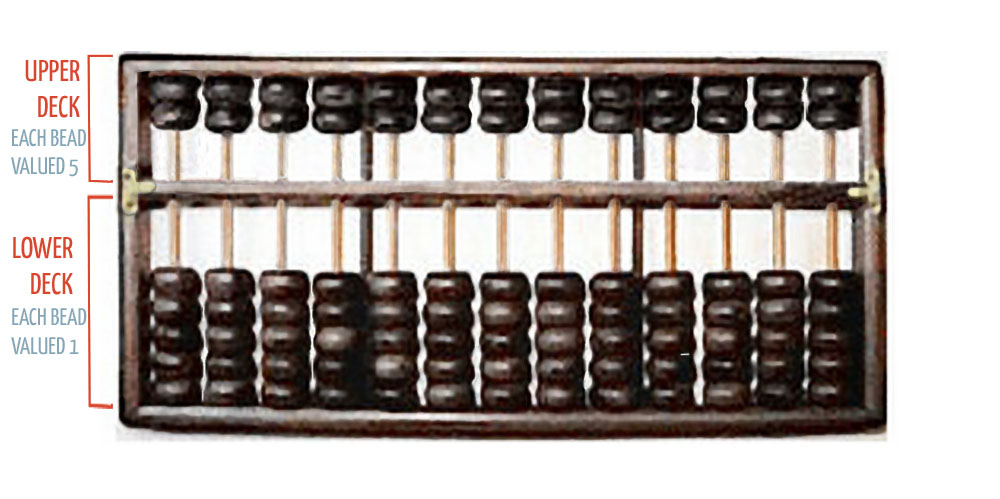The abacus is a mechanical aid used for counting; it is not a calculator in the sense we use the word today.
Anatomy & Construction
The standard abacus can be used to perform addition, subtraction, division and multiplication; the abacus can also be used to extract square-roots and cubic roots. The beads are manipulated with either the index finger or the thumb of one hand.
The abacus is typically constructed of various types of hardwoods and comes in varying sizes. The frame of the abacus has a series of vertical rods on which a number of wooden beads are allowed to slide freely. A horizontal beam separates the frame into two sections, known as the upper deck and the lower deck.
ABACUS PARTS: The various parts of the abacus are identified here: the frame, the beam, the beads and rods and the upper and lower decks.
Preparation & Bead Values
PREPARING THE ABACUS: The abacus is prepared for use ("zeroed") by placing it flat on a table and pushing all the beads on both the upper and lower decks away from the beam by sliding the thumb along the beam.

BEAD VALUES: Each bead in the upper deck has a value of 5; each bead in the lower deck has a value of 1.
Beads are considered counted, when moved towards the Beam— the piece of the abacus frame that separates the two decks.
Counting
After 5 beads are counted in the lower deck, the result is "carried" to the upper deck; after both beads in the upper deck are counted, the result (10) is then carried to the left-most adjacent column.
The right-most column is the ones column; the next adjacent to the left is the tens column; the next adjacent to the left is the hundreds column, and so on. Floating point calculations are performed by designating a space between 2 columns as the decimal-point and all the rows to the right of that space represent fractional portions while all the rows to the left represent whole number digits.
Abacus Applet: Numeric representation of the number: 87,654,321. If your browser is Java-capable then the applet, above, will identify the parts of the abacus in your browser's status-area as you move your mouse-pointer over it; the beads will move when you click on them and the value of each column will be displayed on the top frame.
Referring to the Figure/Applet above, the third column (from the left), representing the number 8, is counted with 1 bead from the top-deck (value 5) and 3 beads from the bottom-deck (each with a value of 1, totaling 3); the sum of the column (5+3) is 8.
Similarly, the fourth column representing the number 7, is counted with 1 bead from the top-deck (value 5) and 2 beads from the bottom-deck (each with a value of 1, totaling 2); the sum of the column (5+2) is 7.
Technique
Proper finger technique is paramount in achieving proficiency on the abacus. With a Chinese abacus, the thumb and the index finger together with the middle finger are used to manipulate the beads. Beads in lower deck are moved up with the thumb and down with the index finger. In certain calculations, the middle finger is used to move beads in the upper deck.
The Java version of the abacus is a limited simulation of the real device because the fingering technique is completely obfuscated by the mouse. Abacus Apps on touch-screen tablets are better simulations. With a real abacus, constant practice is indispensable in achieving virtuosity in calculating speed.
Finger Technique: A Japanese textbook published in 1954 shows the proper technique for moving the beads. It shows the thumb being used to count beads in the lower deck and the index finger being used in all other cases.
With the Japanese version, only the index finger and thumb are used. The beads are moved up with the thumb and down with the index finger. However, certain complex operations require that the index finger move beads up; e.g. adding 3 to 8 (the adding of the three is called Jian Chi Jia Shi which literally means, "subtract 7 add 10").